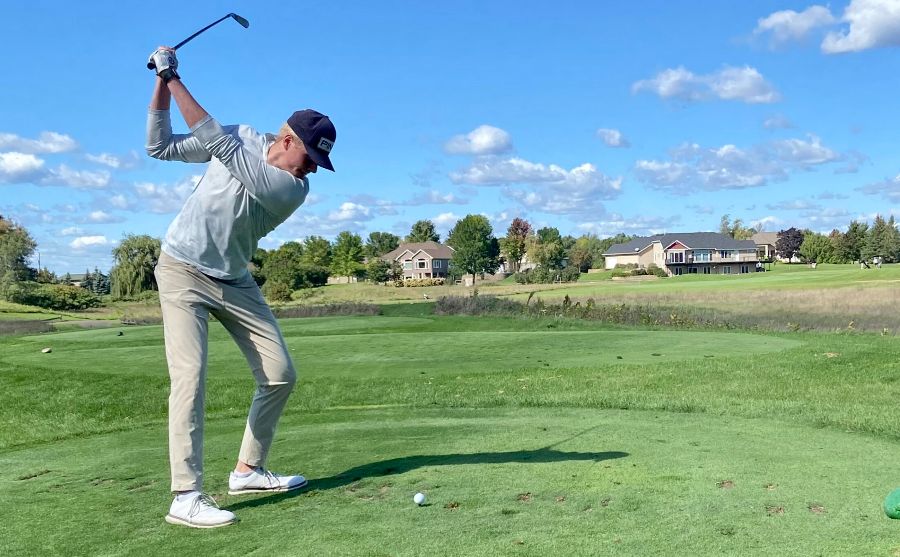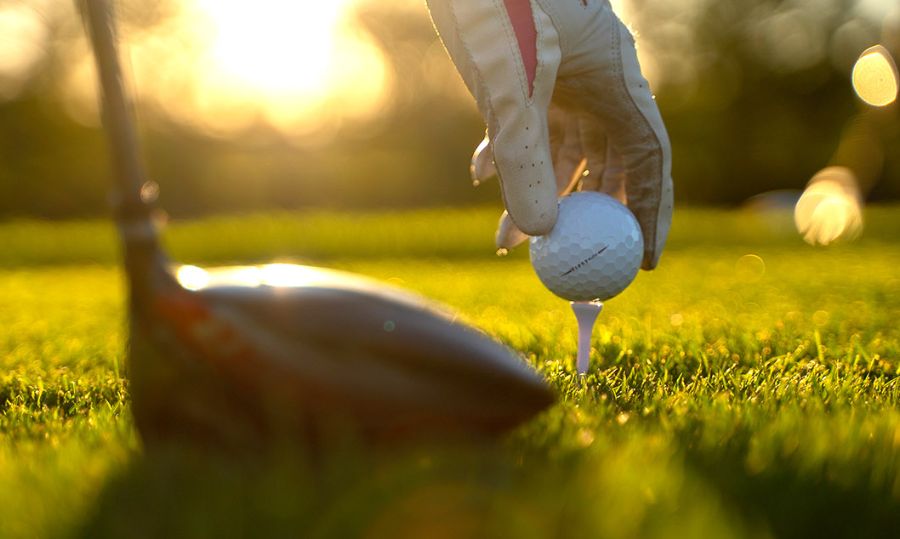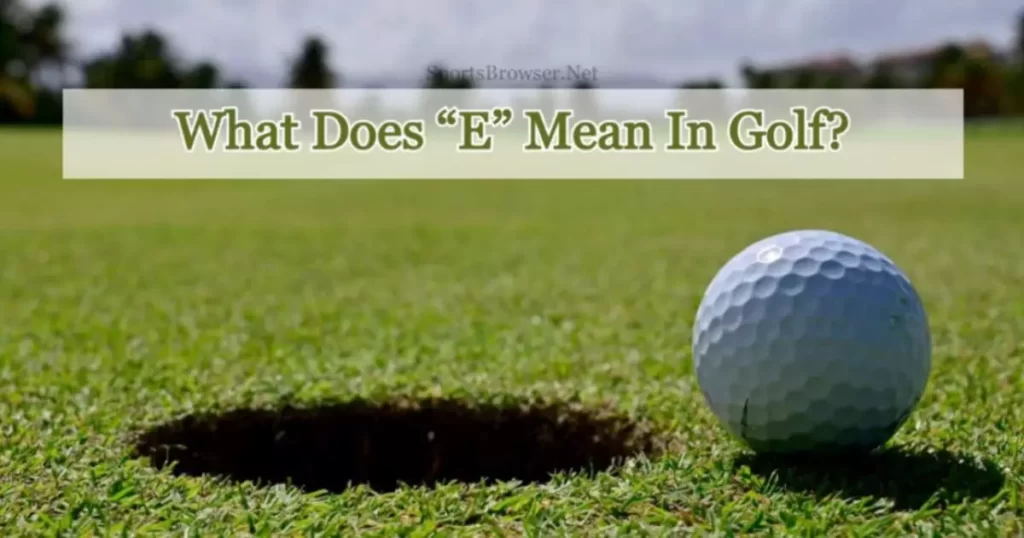What Does “E” Mean In Golf? – An In-Depth Analysis For Golfers
Have you ever wondered what the “E” next to a player’s score meant when you were on the golf course? This small letter can greatly impact a golfer’s overall score. But what exactly does “E” stand for in golf?
In golf, “E” is the symbol used to indicate that a player has scored ‘Even’ for a particular hole. This means that the golfer has taken the same number of strokes as the designated ‘par’ for that hole. For example, if the par for a hole is 4, and the golfer takes 4 strokes to complete it, their score for that hole would be recorded as “4 (E)”.
So, are you curious to learn more about the significance of “E” in golf and how it affects a golfer’s overall score? As the renowned golf instructor David Leadbetter puts it, “Knowing your numbers and what they mean is an important part of playing good golf.” Learn how the PAR System and “E” can help you play better golf as the SportsMonkie team takes deep dive.
Understanding the PAR System and its Relation to “E” in Golf
Centuries of playing and continuous evolution have made golf a popular sport. One of the most important aspects of golf is the PAR system, which plays a crucial role in determining the score and ranking of a player. As we proceed, we will explore PAR and how it relates to the “E” in golf.
What is PAR in Golf?
PAR in golf stands for “Procedure of a Round.” The U.S. Golf Association established this term to indicate the ideal score you should accomplish on any particular hole. PAR, or “par score,” is determined by adding the total number of strokes needed to get the ball into the hole from a predetermined starting point (tee box) on each hole.
Typically, the PAR rating ranges from 3 to 5 strokes per hole, but some holes may receive a higher PAR rating. To determine your PAR score, it’s important to understand and remember which clubs are best for particular shots and how far away you are from the green before taking your shot.
Additionally, knowing how tricky the course is can help plan your shot. Knowing your PAR and playing within it can help you keep track of your overall progress toward reaching better scores over time.
Why is PAR Important in Golf?
PAR is important in golf for several reasons:
- PAR allows you to measure your performance by the standard professional golfers and organizations set.
- Comparing your performance against other golfers and courses is easy with PAR.
- It helps the golf organizers to determine their courses’ difficulty levels so they can make changes to improve them.
- Lastly, It helps you to set goals and track your progress over time.
The Relation Between PAR and “E” in Golf
PAR and “E” in golf are related, but they are not the same. PAR marks the number of strokes it takes to complete a hole. At the same time, “E” is a score that determines your performance relative to PAR. If you score 1 under par, you’ve achieved an E (or eagle). This means you completed the hole in fewer strokes than the number listed as PAR for that specific hole.
At your course’s scoreboard, The score of “E” means you’ve taken the expected number of strokes to complete a hole or a round of golf. If you take more strokes than PAR, your score will be higher, such as +1 or +2. But, If you take fewer strokes than PAR, your score will be lower, such as -1 or -2.
How is PAR Determined in Golf?
The length of the hole largely determines how PAR is determined in golf. Longer holes usually mean higher pars. Whereas shorter holes usually are lower. As such, different golf courses determine their PARs according to their total yardage.

What Does “E” Mean in Golf?
Golf is a sport that requires skill and precision, and it is important to know the golf scoring terms. The letter “E” is placed next to the golfer’s name in their cumulative golf tournament score.
As we already know, Par is the number of strokes an average golfer should take to complete a certain hole on a golf course. This score can range from three to five depending on each hole’s length on a golf course.
The term “E” in a golf leaderboard stands for “even par.” Meaning that the golfer has taken the same number of strokes as the par for that particular hole.
For example, if you are playing a par 4 hole, it would take four strokes for an average golfer to complete this hole. However, pro golfers tend to finish it in fewer strokes. Similarly, if you were playing a par 5 hole, it would take five strokes to complete this one.
What Does The Positive or Negative ‘E’ Mean?
A positive “E” in the scorecard means that the player has finished the hole or round with a score that is better than par. In comparison, a negative “E” means that the player has finished the hole or round with a score worse than par.
These types of ‘E’ are called Birdie and Bogey in golf terminology. Allow me to explain with an example:
You take 4 strokes to complete a hole with a par of 3. Your score on that hole would be indicated as “3+1.” The “+1” indicates that you scored one stroke better than par and achieved a birdie (positive E score of +1).
Conversely, if you score 5 on the same hole, it would be considered a bogey (negative E score of -1).
The Significance of ‘E’ in Golf
Learn how to lower your score on the green by reading these key points about the importance of the letter ‘E’ in golf!
- E stands for ‘Efficiency’ – measuring how efficiently you use your golf shots is important.
- Improving your efficiency reduces the number of times you need to hit a ball and helps lower your score.
- It also helps you figure out which clubs are best suited to certain types of shots so that you can choose the right equipment for each hole.
- Knowing your efficiency can help identify areas where you need improvement, allowing you to focus on practicing those particular skills.
- E also stands for ‘Expectations,’ which refers to the expectations you should have when playing a particular shot.
- Having realistic expectations will help ensure that your technique is sound and that you have a good result.
- Understanding your abilities and what results they can produce will help set achievable targets on the golf course.

Tips to achieve a better “E” in your Golf Game
You can follow these useful tips in golf to improve your game:
- Focus on your swing plane – The swing plane is your club’s path throughout the golf shot.
- To hit accurate shots, you need to ensure that you are consistently hitting the ball along the right plane.
- You can take practice swings by keeping your head down until you have finished the swing. This will help you focus on keeping proper form and connection throughout the swing.
- Practice Effective Visualization – Visualizing the shot before you take it will help ensure that you coordinate all parts of your body together for a successful result. Establish an avatar to represent yourself during your visualization sessions.
- Develop a Pre-Shot Routine – Creating a pre-shot routine can help eliminate any unnecessary movements and assists in focusing during the shot process. Consistently complete it before each golf shot, starting with a deep breath and ending with a positive affirmation about the shot outcome.
- Focus on a smooth transition between your backswing and downswing. A good “transition move” is often the key to added power and distance.
- Choose Club Selection Intelligently – Choosing the correct club for each situation is essential to achieve good “e” in golf effectively. Each club has different characteristic distances and trajectory patterns when hit correctly.
- Get creative! Use different clubs, grips, stands, and ball positions to explore how changes to your setup can affect the path of your shot and its spin rate off the tee.
- Consider factors like wind direction, obstacles on either side of the green, and terrain elevation before deciding on a particular club.
- Understand that hitting the ball farther with a shorter backswing can lead to an increase in distance. To accomplish this, you can utilize the lower body to create more power instead of relying solely on your arms.
Additionally, You should know what kind of impact produces which type of golf shot – is it a draw, fade, or straight shot? Because, The degree of E-factor can affect these types of shots (e.g., hitting with a steeper angle of attack could result in less sidespin).
FAQs
Q. What are the 7 golf scoring terms?
The seven most used golf terms are Birdie, Par, Bogey, Double Bogey, Eagle, Albatross, and Hole-in-One.
Q. What are a birdie and an eagle in golf?
A birdie is one stroke under par on a golf hole. An eagle is two strokes under par on a golf hole.
Q. What score is a bogey in golf?
A bogey in golf is a score of one over par.
Q. What score is an eagle in golf?
An eagle in golf is a score of two under par on a hole.
Q. What does +3 mean in golf?
+3 means that the golfer has scored three strokes under par.
Q. What is a +3 handicap in golf?
+3 handicap in golf measures a golfer’s potential ability, which is determined by taking their average scoring over multiple rounds and adjusting for courses of varying difficulty.
Q. What are 4 birdies in a row called?
A “baker’s dozen” calls four birdies in a row.
In a Nutshell
The “E” in golf stands for even-par, a score achieved when the golfer takes the same number of shots on average to complete a hole.
The PAR system helps determine how long each hole is and how many shots it will take to get around the course.
Golfers can understand their scores by using the relation between PAR and “E” as expressions of the relative difficulty in golf.







